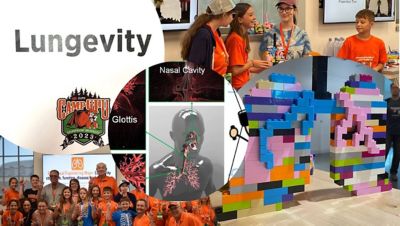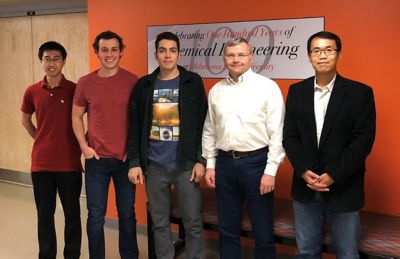-
-
학생용 무료 소프트웨어에 액세스하기
차세대 엔지니어에게 힘을 실어주는 Ansys
학생들은 세계적 수준의 시뮬레이션 소프트웨어를 무료로 이용할 수 있습니다.
-
지금 바로 Ansys에 연결하십시오!
미래를 설계하기
시뮬레이션이 다음 혁신을 어떻게 지원할 수 있는지 알아보려면 Ansys와 연결하십시오.
국가
무료 트라이얼
제품 및 서비스
학습하기
회사 정보
Back
제품 및 서비스
ANSYS BLOG
August 31, 2023
Students Explore Biomedical Research with Ansys CFD
Students at Oklahoma State University (OSU) are taking a closer look at human anatomy using Ansys simulation to explore biomedical research. Much like its name suggests, biomedical engineering unites biology and engineering within the medical field. Essentially, biomedical engineers explore ways to prevent and treat diseases, including advancements in technology, medicine, and equipment. As such, biomedical research requires an in-depth understanding of complex biological systems. However, access to hands-on experience using real-life experiments can be limited for education and training purposes.
To enhance learning in this area, chemical engineering associate professor Yu Feng integrates Ansys Fluent computational fluid dynamics (CFD) software into select undergraduate and graduate courses at OSU. With access to the software through the Ansys Academic Program, Feng empowers students to explore biomedical research and physiological processes more interactively through visualization and CFD simulation.
Examining Fluid Dynamics Up Close
Since joining the university in 2016, Feng has implemented Fluent in various undergraduate and graduate engineering courses, including Chemical Engineering Process Modeling and Introduction to Computational Fluid-particle Dynamics. As he explains, biomedical research study not only requires students to understand advanced computational methods, including CFD, finite element method (FEM), fluid-structure interaction, and discrete element method (DEM), but it also requires that students are able to visualize and analyze simulation results appropriately.
“Due to the great capability of Ansys software, which can provide computational methods as well as post-processing capabilities, I feel that integrating Ansys from the first day that I offered this course significantly enhanced the teaching outcomes to not only the graduate students, but also the undergraduate students,” says Feng. “Additionally, Ansys is always developing and expanding its software capabilities. It has great potential and has been widely used by industry, including mechanical, civil, chemical, and biomedical engineering. Learning Ansys will significantly enhance the students’ chances of getting hired by companies that need computational engineers to do CFD simulations for them.”
Students use Fluent in a number of research projects, including the examination of transient blood flow in arm arteries, topical ocular drug delivery through 3D eyeball models, and airborne transmission of virus-laden droplets in between digital twin human respiratory systems (see Figure 1).
“The hands-on simulation experience has proven to be a vital tool in helping students comprehend complex processes,” Feng says. “By visualizing the spatiotemporal distributions of various variables like velocity, pressure, temperature, stress, and concentration, students gain a deeper understanding of the subject matter. These high-resolution results, which are often difficult to obtain through experiments, become achievable using Ansys software.”

Figure 1. Research examples of lung aerosol dynamics, hemodynamics in arm arteries, and topical ocular delivery optimization demonstrated using Ansys simulation and a virtual human model developed by the Computational Biofluidics and Biomechanical Laboratory (CBBL) at Oklahoma State University (OSU).
In addition to visualization, Feng says Ansys’ flexible customization capabilities, such as user-defined functions (UDFs), help further education by giving advanced students the chance to explore the simulation beyond Ansys’ built-in solvers.
Feng says the Ansys Academic Program has been pivotal in progressing education in his courses. With Ansys’ free student software available online, Feng can easily integrate the simulation into curriculum for in-class or at-home learning. However, the licenses provided through the Ansys Academic Program have really expanded his simulation use.
“Ansys’ free student licenses have been an invaluable resource for me as an instructor to integrate Ansys software and simulations into my courses. However, these licenses come with a limitation on the total mesh element number that can be used for simulations,” he says. “As a result, I find that obtaining Ansys Academic Program licenses has been immensely beneficial, as it allows me to introduce simulations with higher mesh element numbers, making the applications closer to realistic scenarios in the industry.”
Feng and his students also benefit from program features, including Ansys Innovation Space and the Ansys Learning Hub, for additional learning and technical support.
In addition to Fluent, Feng incorporates other Ansys tools into coursework:
- Ansys Mechanical for solid mechanics simulation and fluid-structure interaction.
- Ansys CFX for CFD simulations as an alternative to Fluent.
- Ansys CFX-Post and Ansys EnSight for post-processing simulation data and visualization.
- Ansys Discovery for quick engineering simulation and analysis.
- Ansys Workbench for fluid–structure interaction and batch process for simulations, as well as training and testing for reduced order models (ROM).
- Ansys Rocky for particle–particle interaction simulations.
Applying Biomedical Education Beyond the Classroom
Outside of the classroom, Feng implements Ansys software to promote the next generation of science, technology, engineering, and math (STEM) through multiple outreach activities for K-12 students, undergraduate students, and the local community in Oklahoma. The objective is to popularize the concepts of in silico pulmonary healthcare, i.e., simulation-based testing, and increase STEM engagement in using in silico models to promote public health in human respiratory systems.

Figure 2. Lungevity outreach session during the Grandparent University (GPU) Program at OSU, organized by Dr. Yu Feng's research lab. The session aims to introduce K-12 students to the concept of in silico pulmonary healthcare, showcasing cutting-edge research advancements through computational methods.
Main activities include the Lungevity initiative hosted by the OSU Alumni Association and the Summer Bridge program organized by the OSU’s College of Engineering, Architecture, and Technology (CEAT). Both programs explore applications, including pulmonary healthcare, hemodynamics, and ocular drug delivery.
Lungevity is a two-day session specifically designed for students ages 7-12 and centered around in silico pulmonary healthcare. The session is held during Grandparent University (GPU), a three-day summer camp in which students and their grandparents visit OSU for a unique intergenerational learning experience. Students and their grandparents participate in several hands-on activities using Ansys simulation. Activities include building Lego airways to visualize the physiological structures of the lung, creating balloon lung models with different elasticities to explore breathing capabilities, modeling how pulmonary air-particle flow simulations help physicians optimize inhalation therapy, and more.
Feng also integrates Ansys simulation during Summer Bridge, a three-week preparatory program for incoming engineering first-year students who will attend OSU. For this year’s group, Feng designed a computational project in Workbench using an ocular drug delivery module and a pulmonary targeted-delivery module.
Along with outreach, Feng’s students also have access to an on-site research lab with state-of-the-art models and equipment. Through the academic partnership between Ansys, Engineering Simulation and Scientific Software (ESSS), and the Computational Biofluidics and Biomechanics Laboratory (CBBL) at OSU, Feng and peers developed a CFD-DEM-based human respiratory system modeling framework that includes a clinically validated elastic whole-lung model.
The new digital model can simulate airflow and the inhalation of aerosolized medication in both healthy and diseased lungs. This comprehensive model covers the entire respiratory pathway, from the mouth and nose to the alveoli, and it includes the deformation kinematics often ignored by other models. By incorporating pulmonary air-particle flow dynamics using techniques such as the Euler-Lagrange method, dynamic mesh method, DEM, and physiologically based pharmacokinetic (PBPK) modeling, and fine-tuning with clinical data, CBBL’s model provides precise results on airway dynamics as well as the uptake and movement of aerosolized particles and vapor in various lung conditions.

Figure 3. Overall schematic of CBBL’s all-in-one, virtual human testing platform for inhaler innovation.
Currently, one graduate student is using the model to study how lung disease can change airway deformation kinematics and breathing capability, as well as inhaled aerosol transport and deposition. Feng says the model can also be used to accelerate drug approval requirements and reduce the cost and time associated with inhaler innovation.
Biomedical research often deals with complex physiological systems, specifically the respiratory system. In fact, according to Feng, one of the top challenges in respiratory research is understanding complex biological systems. Fluent’s capability for predicting multiphase flow dynamics with spatiotemporal resolution allows students and researchers to simulate and visualize fluid flow in these systems, providing a deeper understanding of their behavior. Other challenges that Ansys simulation has helped Feng’s lab overcome include patient-specific modeling, drug delivery and medical device optimization, and more while combining multiphysics simulations for more realistic and comprehensive biomedical scenarios.
“Ansys CFD and other simulation tools are significant in biomedical research and various health-related fields, including pulmonary healthcare, pulmonary exposure risk assessment, and ocular drug delivery which my lab’s research is currently focusing on,” he says. “These simulation techniques offer numerous benefits that contribute to advancing research, optimizing treatments, and enhancing patient outcomes.”

Figure 4. Thierry Marchal, an industry director for healthcare solutions at Ansys (second from right), visits Yu Feng, a chemical engineering associate professor at OSU (far right) and past lab members at the CBBL in 2017.
Reshaping the Future of Biomedical Research
Graduates from Feng’s lab have secured positions as research scientists in prestigious institutions such as the Cincinnati Children’s Hospital, the Food and Drug Administration (FDA), and several research labs in Ohio, including the Experimental Fluid Dynamics Lab at Wright State University.
“Chemical engineering students who master Ansys Fluent and CFX have achieved remarkable success in their careers after completing their undergraduate education,” says Feng. “They have skillfully applied the knowledge they gained from my multiphase flow course, and their success can be attributed to their proficiency in Ansys software, including Fluent, CFX, Mechanical, Rocky, and others.”
To learn more about Feng’s research and how to integrate Ansys CFD into educational programs, register for the upcoming webinar “Integrating Ansys into Teaching: CFD for Healthcare,” scheduled for Wednesday, September 20, at 11 a.m. EST.